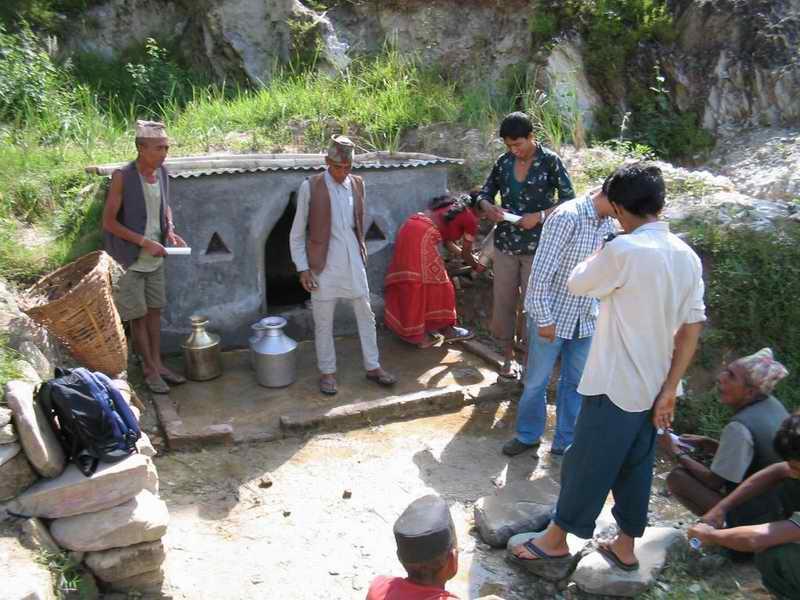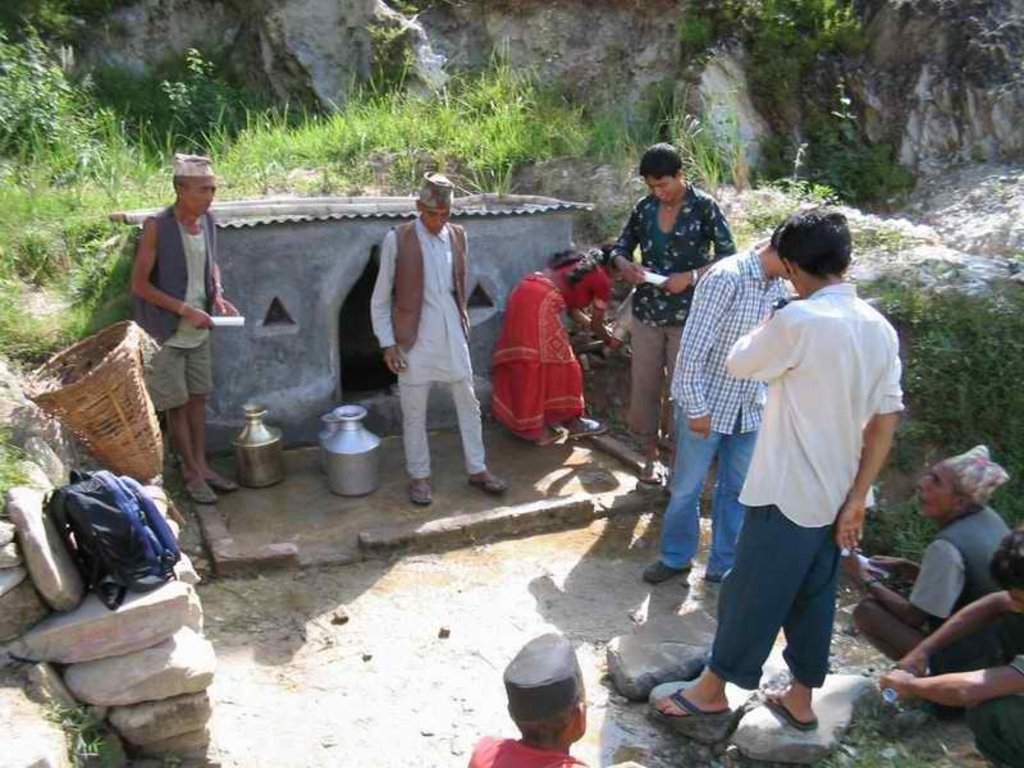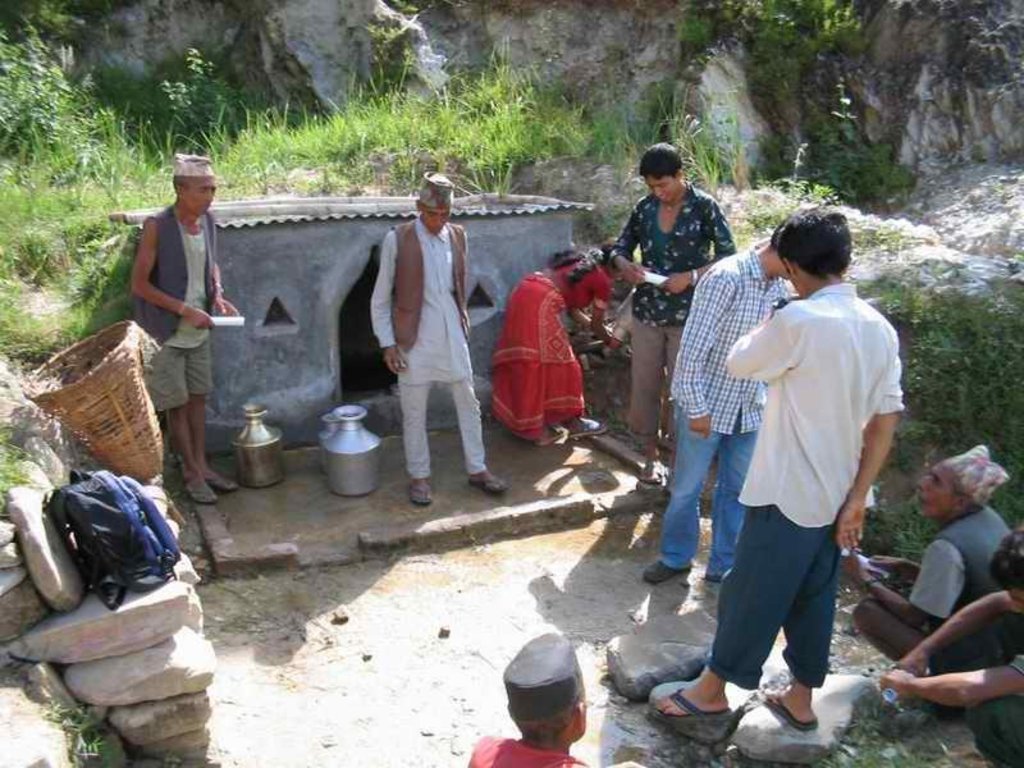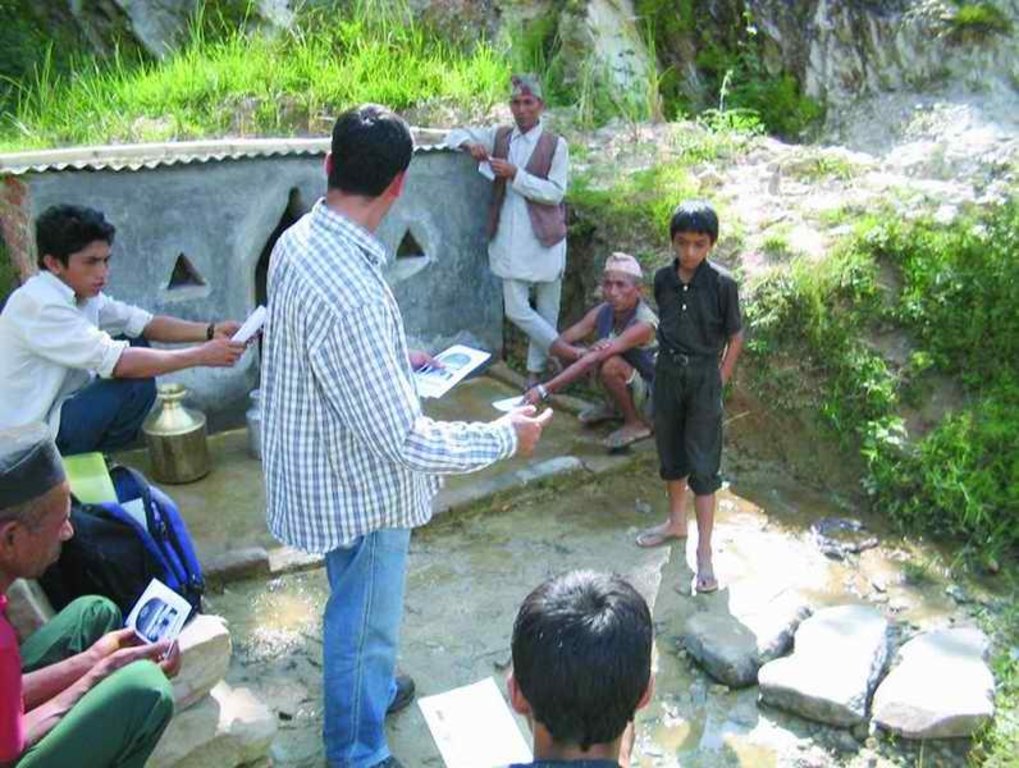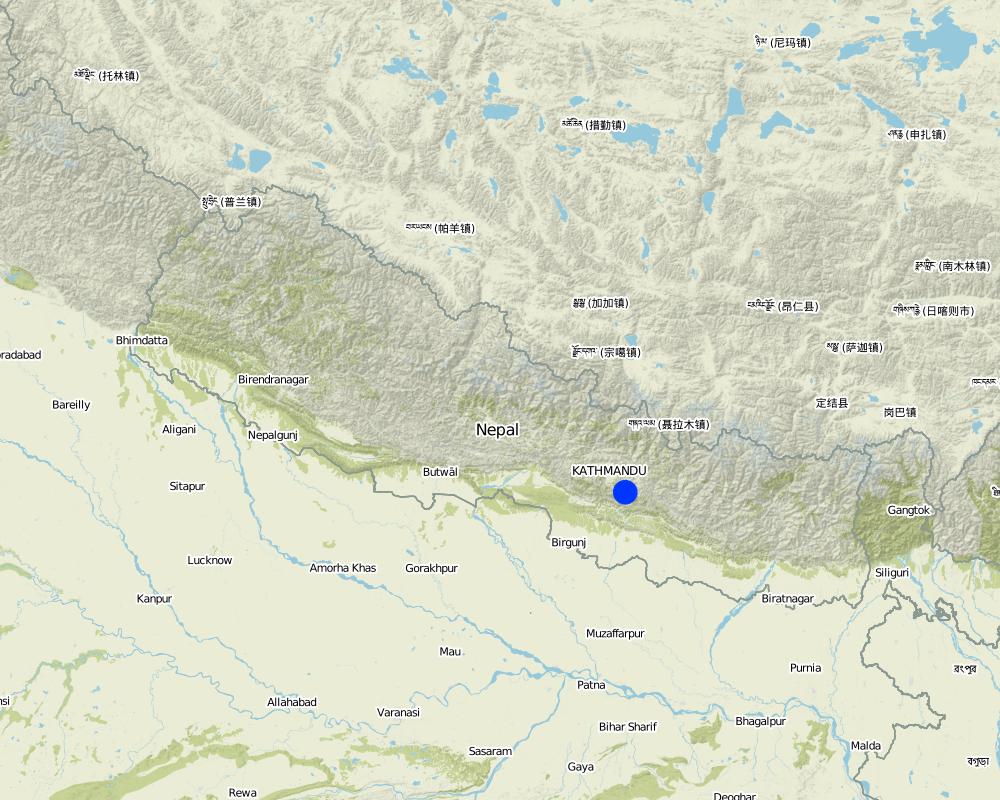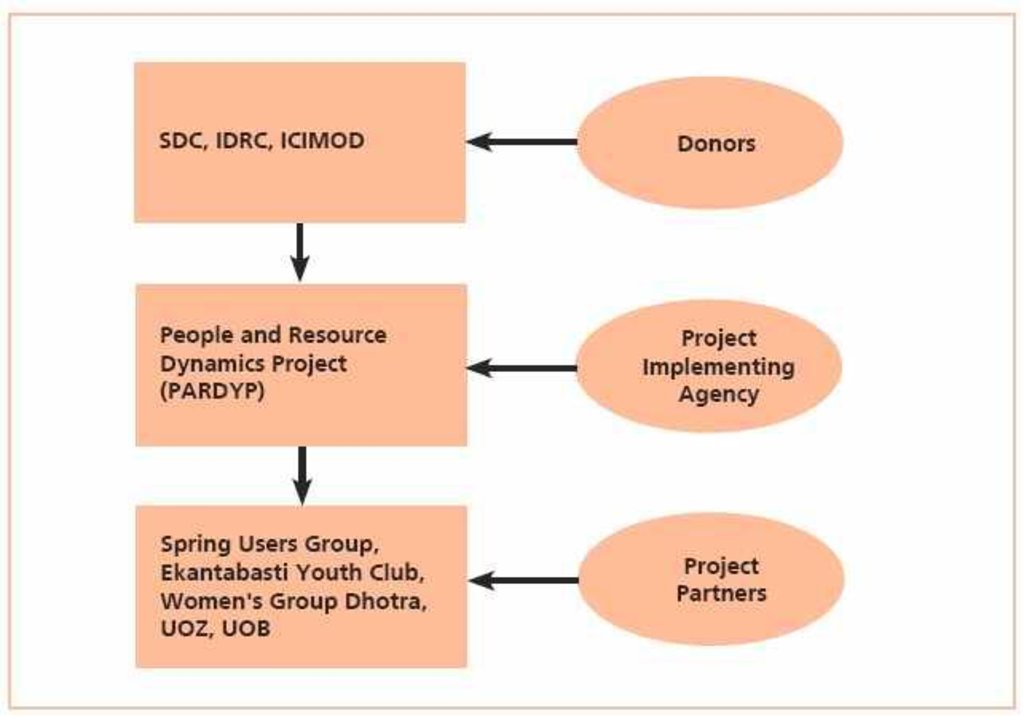Community efforts for improving drinking water quality [ເນໂປ]
- ການສ້າງ:
- ປັບປູງ:
- ຜູ້ສັງລວມຂໍ້ມູນ: Madhav Dhakal
- ບັນນາທິການ: –
- ຜູ້ທົບທວນຄືນ: Fabian Ottiger
Piune paani ko gunastar sudhar ka lagi samudayik prayas
approaches_2352 - ເນໂປ
ເບິ່ງພາກສ່ວນ
ຂະຫຍາຍທັງໝົດ ຍຸບທັງໝົດ1. ຂໍ້ມູນທົ່ວໄປ
1.2 ລາຍລະອຽດ ການຕິດຕໍ່ ຂອງບຸກຄົນທີ່ຊັບພະຍາກອນ ແລະ ສະຖາບັນ ການມີສ່ວນຮ່ວມ ໃນການປະເມີນຜົນ ແລະ ເອກະສານ ຂອງວິທີທາງ
ຜູ້ຊ່ຽວຊານ ດ້ານການຄຸ້ມຄອງ ທີ່ດິນແບບຍືນຍົງ:
Isabelle Provodoli
himcat@icimod.org
International Centre for Integrated Mountain Development (ICIMOD), GPO
Box. 3226, Kathmandu
ເນໂປ
ຊື່ຂອງ ສະຖາບັນການຈັດຕັ້ງ ທີ່ອໍານວຍຄວາມສະດວກ ໃນການສ້າງເອກກະສານ ຫຼື ປະເມີນແນວທາງ (ຖ້າກ່ຽວຂ້ອງ)
CDE Centre for Development and Environment (CDE Centre for Development and Environment) - ສະວິດເຊີແລນຊື່ຂອງ ສະຖາບັນການຈັດຕັ້ງ ທີ່ອໍານວຍຄວາມສະດວກ ໃນການສ້າງເອກກະສານ ຫຼື ປະເມີນແນວທາງ (ຖ້າກ່ຽວຂ້ອງ)
ICIMOD International Centre for Integrated Mountain Development (ICIMOD) - ເນໂປ1.3 ເງື່ອນໄຂ ຂອງການນໍາໃຊ້ເອກກະສານຂໍ້ມູນ ຂອງ WOCAT
ຜູ້ສັງລວມ ແລະ ບັນດາຜູ້ຕອບແບບສອບຖາມ ຍອມຮັບໃນເງື່ອນໄຂ ການນໍາໃຊ້ຂໍ້ມູນເອກະສານ ທີ່ສ້າງຂື້ນ ໂດຍຜ່ານ ອົງການ WOCAT:
ແມ່ນ
1.4 ເອກະສານອ້າງອີງ (ຫຼາຍ) ກັບແບບສອບຖາມ (ຫຼາຍ) ເຕັກໂນໂລຢີ ຂອງດ້ານການຄຸ້ມຄອງ ດິນແບບຍືນຍົງ
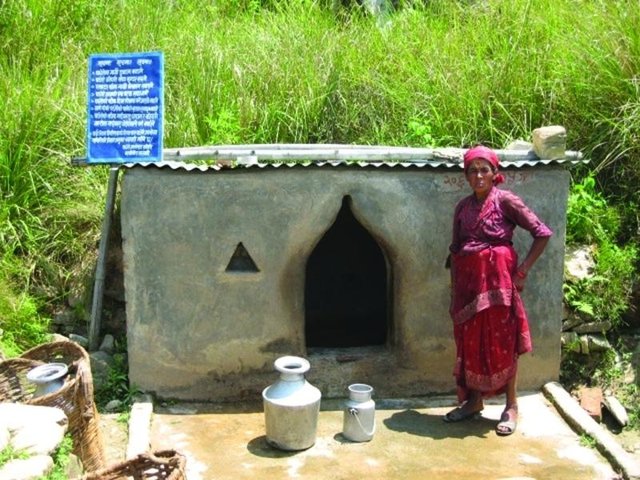
Drinking water quality improvement through conservation measures [ເນໂປ]
Structural and vegetative measures to improve the quality of drinking water contaminated due to poor sanitation and seepage
- ຜູ້ສັງລວມຂໍ້ມູນ: Madhav Dhakal
2. ພັນລະນາ ແນວທາງການຄຸ້ມຄອງນໍາໃຊ້ດິນແບບຍືນຍົງ
2.1 ການອະທິບາຍ ໂດຍຫຍໍ້ ຂອງວິທີທາງ
Working with communities to demonstrate and disseminate methods for improving drinking water quality using structural and vegetative measures
2.2 ການອະທິບາຍ ລາຍລະອຽດ ຂອງວິທີທາງ
ການອະທິບາຍ ລາຍລະອຽດ ຂອງວິທີທາງ:
Aims / objectives: The People and Resource Dynamics in Mountain Watersheds of the Hindu Kush- Himalayas Project (PARDYP) implemented this approach with 30 drinking water user households at Barbot in the Jhikhu Khola watershed, Kavre Palanchok. The aim was to improve water quality and availability from an open spring source through participatory planning and implementation. The approach first identified local concerns and observed the sanitary situation of the catchment area. Meetings were held jointly with men and women users from different caste groups (Brahmin, Chhetri, Newar and Kami) to discuss the problems and issues and to identify viable solutions. The advantages and disadvantages of the various options were discussed, after which users selected the following three measures to improve the drinking water supply: 1) building a brick-cement walled structure around the main local spring, 2) establishing check dams across nearby rills and gullies, and 3) planting grass around the spring box and tree saplings within the catchment area. The aim was to prevent direct flow of surface water into the spring and reduce contamination and turbidity of the source. Understanding and support was gained by demonstrating the technology and running an awareness campaign.
Role of stakeholders: The project helped form a users committee made up of 11 women and 1 man and encouraged them to plant grass and tree seedlings across the entire catchment. The project regularly measured the quality of the water and shared the results with the users. Rules and regulations were developed to ensure equitable access to the spring and its sustainable use and management. A notice board with do’s and don’ts was placed near the spring. The users held monthly meetings and established a revolving fund for maintaining the structures. Spring users followed the rules and regulations by washing, cleaning, and bathing at separate sources. Livestock grazing was stopped in the nearby area and the area was regularly cleaned. Furthermore, users were encouraged to treat water for drinking using simple methods like SODIS and the low cost Safa filter to avoid microbiological contamination. They were made more aware of water quality, sanitation, and health issues.
2.3 ຮູບພາບຂອງແນວທາງ
2.5 ປະເທດ / ເຂດ / ສະຖານທີ່ບ່ອນທີ່ແນວທາງໄດ້ຖືກນໍາໃຊ້
ປະເທດ:
ເນໂປ
ຂໍ້ມູນເພີ່ມເຕີມຂອງສະຖານທີ່:
Kavrepalanchowk district/ Jhikhu Kholawatershed
Map
×2.6 ວັນທີເລີ່ມຕົ້ນ ແລະ ສິ້ນສຸດ ການຈັດຕັ້ງປະຕີບັດ ວິທີທາງ
ປີທີ່ສີ້ນສູດ (ຖ້າຢຸດບໍ່ໄດ້ນໍາໃຊ້ ວິທີທາງ):
2005
2.7 ປະເພດຂອງແນວທາງ
- ພາຍໃຕ້ໂຄງການ / ແຜນງານ
2.8 ເປົ້າໝາຍ / ຈຸດປະສົງຫຼັກ ຂອງການຈັດຕັ້ງປະຕິບັດ ວິທີທາງ
The Approach focused on SLM only
- To explore and demonstrate appropriate water quality improving technologies and methods in a participatory way. - To increase awareness on water quality, water treatment, and health and hygiene. - To share knowledge gained on the water improvement options with farmers and other stakeholders
The SLM Approach addressed the following problems: Weak institutional collaboration to develop technological options for improving drinking water quality and availability and to raise awareness on health and hygiene and waterborne diseases.
2.9 ເງື່ອນໄຂອໍານວຍ ຫຼື ຂັດຂວາງການປະຕິບັດຂອງເຕັກໂນໂລຢີ / ເຕັກໂນໂລຢີການນໍາໃຊ້ຕາມແນວທາງ
ມີຄວາມສາມາດ / ເຂັ້າເຖິງຊັບພະຍາກອນດ້ານການເງິນ ແລະ ການບໍລິການ
- ເຊື່ອງຊ້ອນ
For the maintenance of the implemented technology
Treatment through the SLM Approach: Revolving fund collected by users
ການກໍ່ຕັ້ງສະຖາບັນ
- ເຊື່ອງຊ້ອນ
Weak institutional collaboration
Treatment through the SLM Approach: User group formed linking local community organisations
ກ່ຽວກັບກົດໝາຍ (ສິດນໍາໃຊ້ດິນ, ສິດນໍາໃຊ້ນໍ້າ)
- ອໍານວຍ
The existing land ownership, land use rights / water rights greatly helped the approach implementation: mostly state owned land and some private land - which helped implementating the technology as there was no conflict.
ຄວາມຮູ້ກ່ຽວກັບການຄຸ້ມຄອງ ທີ່ດິນແບບຍືນຍົງ, ການເຂົ້າເຖິງການສະໜັບສະໜູນ ທາງດ້ານວິຊາການ
- ເຊື່ອງຊ້ອນ
Different water treatment methods
Treatment through the SLM Approach: Awareness of structural and vegetative measures; direct water treatment methods including Safa filter, SODIS, chlorination
3. ການມີສ່ວນຮ່ວມ ແລະ ບົດບາດຂອງພາກສ່ວນທີ່ກ່ຽວຂ້ອງທີ່ໄດ້ມີສ່ວນຮ່ວມ
3.1 ຜູ້ມີສ່ວນຮ່ວມ ໃນວິທີທາງ ແລະ ພາລະບົດບາດ ຂອງເຂົາເຈົ້າ
- ຜູ້ນໍາໃຊ້ດິນໃນທ້ອງຖິ່ນ / ຊຸມຊົນທ້ອງຖິ່ນ
Land users worked equally divided between men and women
Improvement of drinking water quality and quantity was the major concern of all spring users.
- ອົງການຈັດຕັ້ງ ທີ່ບໍ່ຂື້ນກັບລັດຖະບານ
- ພະນັກງານຂັ້ນສູນກາງ (ຜູ້ວາງແຜນ, ຜູ້ສ້າງນະໂຍບາຍ)
- ອົງການຈັດຕັ້ງ ສາກົນ
PARDYP/ICIMOD
ຖ້າຫາກມີຫຼາຍພາກສ່ວນທີ່ເຂົ້າຮ່ວມ ໃຫ້ລະບຸ ອົງການທີ່ເປັນຫຼັກ ໃນການຈັດຕັ້ງປະຕິບັດ:
Concept designed by national specialist and implemented jointly with users
3.2 ການມີສ່ວນຮ່ວມຂອງຜູ້ນໍາໃຊ້ທີ່ດິນໃນທ້ອງຖິ່ນ / ຊຸມຊົນທ້ອງຖິ່ນໃນໄລຍະທີ່ແຕກຕ່າງກັນຂອງແນວທາງ
| ການລວບລວມ ເອົາຜູ້ນໍາໃຊ້ດິນ ໃນທ້ອງຖິ່ນ / ຊຸມຊົນທ້ອງຖິ່ນ | ໃຫ້ລະບຸ ຜູ້ໃດທີ່ມີສ່ວນຮ່ວມ ໃນແຕ່ລະກິດຈະກໍາ? | |
|---|---|---|
| ການເລີ່ມຕົ້ນ / ແຮງຈູງໃຈ | ການຮ່ວມມື | public meetings; meetings organised to identify problems and possible options to overcome them. |
| ການວາງແຜນ | ການຮ່ວມມື | public meetings; organised regularly to identify implementing steps, and role and responsibility of different stakeholders in overcoming problems |
| ການປະຕິບັດ | ການຮ່ວມມື | responsibility for major steps; the user group responsible for implementation and the project for technical support |
| ຕິດຕາມກວດກາ / ການປະເມີນຜົນ | ການຮ່ວມມື | The quality of the water was measured in each season to monitor the impact of the technology. Detailed progress reports, results, and lessons learned were shared with district level institutions and authorities, water quality reports were shared with spring users at public meetings |
| Research | ການບໍ່ປະຕິບັດ | Water quality and availability recorded before and after technology implemented. Studies on access to water and confl icts among users |
3.3 ແຜນວາດ (ຖ້າມີ)
ການອະທິບາຍ:
PARDP project donors and implementing partners-- SDC: Swiss Agency for Development and Cooperation IDRC: International Development Research Centre ICIMOD: International Centre for Integrated Mo
ຜູ້ຂຽນ:
Madhav Dhakal
3.4 ການຕັດສິນໃຈກ່ຽວກັບການຄັດເລືອກເຕັກໂນໂລຢີຂອງການຄຸ້ມຄອງທີ່ດິນແບບຍືນຍົງ / ເຕັກໂນໂລຢີ
ລະບຸ ຄົນທີ່ຕັດສິນໃຈ ກ່ຽວກັບການຄັດເລືອກຂອງ ເຕັກໂນໂລຢີ / ເຕັກໂນໂລຢີ ຈະໄດ້ຮັບການປະຕິບັດ:
- ຜູ້ນໍາໃຊ້ທີ່ດິນຫຼັກ, ການສະໜັບສະໜູນ ໂດຍຜູ້ຊ່ຽວຊານ ການນໍາໃຊ້ທີ່ດິນແບບຍືນຍົງ
ອະທິບາຍ:
Users selected three of the potential conservation options.
Decisions on the method of implementing the SLM Technology were made by mainly by land users supported by SLM specialists. The technology and associated measures were not new to the area and the implementing methods were simple and have been practised for a long time. The project initiated the formation of a users committee and the committee conducted the conservation activities.
4. ການສະໜັບສະໜູນທາງດ້ານວິຊາການ, ການສ້າງຄວາມສາມາດ, ແລະ ການຈັດການຄວາມຮູ້.
4.1 ການສ້າງຄວາມສາມາດ / ການຝຶກອົບຮົມ
ຜູ້ນໍາໃຊ້ທີ່ດິນ ຫຼື ພາກສ່ວນກ່ຽວຂ້ອງອື່ນໆ ໄດ້ຮັບການຝຶກອົບຮົມບໍ່?
ແມ່ນ
ໃຫ້ລະບຸ ຜູ້ໃດທີ່ໄດ້ຮັບການຝຶກອົບຮົມ:
- ຜູ້ນໍາໃຊ້ດິນ
ຮູບແບບຂອງການຝຶກອົບຮົມ:
- ກອງປະຊຸມ
ໃນຫົວຂໍ້:
Concept of conservation measures, and methods of treating contaminated water using SODIS and safa filter.
4.2 ການບໍລິການໃຫ້ຄໍາປຶກສາ
ເຮັດຜູ້ໃຊ້ທີ່ດິນມີການເຂົ້າເຖິງການບໍລິການໃຫ້ຄໍາປຶກສາ?
ແມ່ນ
ລະບຸວ່າການສະໜອງ ການບໍລິການ ໃຫ້ຄໍາປຶກສາ:
- ໃນພື້ນທີ່ຂອງຜູ້ນໍາໃຊ້ດິນ
ອະທິບາຍ / ຄວາມຄິດເຫັນ:
Name of method used for advisory service: Sharing information on water quality status, and raising awareness among users.; Key elements: catchment conservation, health hygiene, water treatment methods; 1) Advisory service was carried out through: projects own extension structure and agents; Extension staff: specifically hired project employees 2) Target groups for extension: land users; Activities: awareness on health hygiene; catchment conservation activities and water treatment methods were shared during meetings.
Advisory service is quite adequate to ensure the continuation of land conservation activities
4.3 ສະຖາບັນການສ້າງຄວາມເຂັ້ມແຂງ (ການພັດທະນາອົງການຈັດຕັ້ງ)
ສະຖາບັນ ໄດ້ຮັບການສ້າງຕັ້ງຂື້ນ ຫຼື ໄດ້ຮັບການສ້າງຄວາມເຂັ້ມແຂງ ໂດຍການຈັດຕັ້ງປະຕິບັດ ວິທີທາງບໍ່?
- ມີ, ໜ້ອຍໜຶ່ງ
ລະບຸ ທາງສະຖາບັນ ໄດ້ສ້າງຄວາມເຂັ້ມແຂງ ໃນລະດັບໃດ (ຫຼາຍ):
- ທ້ອງຖິ່ນ
ລະບຸ ປະເພດ ຂອງສະໜັບສະໜູນ:
- ການສ້າງຄວາມອາດສາມາດ / ການຝຶກອົບຮົມ
ໃຫ້ລາຍລະອຽດເພີ່ມເຕີມ:
Training on water quality treatment provided to local club
4.4 ຕິດຕາມກວດກາ ແລະ ປະເມີນຜົນ
ການຈັດຕັ້ງປະຕິບັດ ວິທີທາງ ໄດ້ມີການປະເມີນຜົນ ແລະ ຕິດຕາມບໍ?
ແມ່ນ
ຄວາມຄິດເຫັນ:
bio-physical aspects were ad hoc monitored through observations; indicators: land use and degradation, sanitary inspection, history of spring, available resources to trap water
technical aspects were regular monitored through measurements; indicators: seasonal water quality and discharge
socio-cultural aspects were ad hoc monitored through observations; indicators: number of spring users, household water requirements, users' issues
no. of land users involved aspects were regular monitored through measurements; indicators: participation in conservation activities
There were few changes in the Approach as a result of monitoring and evaluation: The project consulted with the local women's cooperative to solve a conflict over water quantity and access to spring source.
4.5 ການຄົ້ນຄວ້າ
ນີ້້ແມ່ນສ່ວນໜຶ່ງ ການຄົ້ນຄວ້າ ຂອງວິທີທາງບໍ່?
ແມ່ນ
ລະບຸ ຫົວຂໍ້:
- ສັງຄົມ
- ເຕັກໂນໂລຢີ
ໃຫ້ຂໍ້ມູນ ເພີ່ມເຕີມ ແລະ ກໍານົດ ຜູ້ໃດເຮັດການຄົ້ນຄວ້າ:
Access to drinking water, conflicts at water fetching times, water quality and quantity measurement, and effectiveness of water treatment methods.
Research was carried out on station
5. ການສະໜັບສະໜູນທາງດ້ານການເງິນ ແລະ ອຸປະກອນຈາກພາຍນອກ
5.1 ງົບປະມານປະຈໍາປີ ສໍາລັບວິທີທາງ ຂອງການຄຸ້ມຄອງ ທີ່ດິນແບບຍືນຍົງ
ຖ້າຫາກບໍ່ຮູ້ຈັດງົບປະມານທີ່ແນ່ນອນ ແມ່ນໃຫ້ປະມານເອົາ:
- < 2,000
ຄໍາເຫັນ (ຕົວຢ່າງ: ແຫຼ່ງຂໍ້ມູນຫຼັກ ຂອງການສະໜອງທຶນ / ຜູ້ໃຫ້ທຶນທີ່ສໍາຄັນ):
Approach costs were met by the following donors: international (SDC, IDRC, ICIMOD): 90.0%; local community / land user(s) (users group): 10.0%
5.3 ເງິນສົມທົບສໍາລັບການນໍາໃຊ້ສະເພາະປັດໃຈຂາເຂົ້າໃນການຜະລີດກະສິກໍາ (ລວມທັງແຮງງານ)
- ອື່ນໆ
| ອື່ນໆ (ລະບຸ) | ທີ່ຂອບເຂດ | ລະບຸ ການອຸດໜູນ |
|---|---|---|
| Planting materials |
ຖ້າແຮງງານ ຂອງຜູ້ນໍາໃຊ້ດິນ ໄດ້ຮັບການສະໜັບສະໜູນ ປັດໃຈຂາເຂົ້າ, ແມ່ນບໍ່:
- ການອາສາ
ຄວາມຄິດເຫັນ:
In implementing the technology and the approach
5.4 ສິນເຊື່ອ
ໄດ້ປ່ອຍສິນເຊື່ອ ສະໜອງໃຫ້ພາຍໃຕ້ ວິທີການສໍາລັບກິດຈະກໍາ ການຄຸ້ມຄອງ ທີ່ດິນແບບຍືນນຍົງບໍ່?
ແມ່ນ
6. ວິເຄາະຜົນກະທົບ ແລະ ສັງລວມບັນຫາ
6.1 ຜົນກະທົບຂອງແນວທາງ
ການຈັດຕັ້ງປະຕິບັດ ວິທີທາງ ສາມາດຊ່ວຍຜູ້ນໍາໃຊ້ທີ່ດິນ ໃນການຈັດຕັ້ງປະຕິບັດ ແລະ ບໍາລຸງຮັກສາ ເຕັກໂນໂລຢີ ການຄຸ້ມຄອງ ທີ່ດິນແບບຍືນຍົງໄດ້ບໍ?
- ບໍ່
- ມີ, ໜ້ອຍໜຶ່ງ
- ມີ, ພໍສົມຄວນ
- ມີ, ຫຼາຍ
To build awareness on SLM and methods of improving drinking water quality. It also helped users to work in a group.
Did other land users / projects adopt the Approach?
- ບໍ່
- ມີ, ໜ້ອຍໜຶ່ງ
- ມີ, ພໍສົມຄວນ
- ມີ, ຫຼາຍ
Similar approaches are being followed in other communities across Nepal.
6.2 ແຮງຈູງໃຈຫຼັກຂອງຜູ້ນໍາໃຊ້ທີ່ດິນໃນການປະຕິບັດການຄຸ້ມຄອງທີ່ດິນແບບຍືນຍົງ
- ການຫຼຸດຜ່ອນພາລະວຽກ
due to reduced water fetching time (or distance).
- ຄວາມຮັບຮູ້ ທາງສີ່ງແວດລ້ອມ
Improved heath due to clean water and better sanitation
6.3 ຄວາມຍືນຍົງຂອງກິດຈະກໍາວິທີທາງ
ຜູ້ນໍາໃຊ້ ທີ່ດິນ ສາມາດສືບຕໍ່ ການຈັດຕັ້ງປະຕິບັດ ຜ່ານວິທີທາງໄດ້ບໍ່ (ໂດຍປາດສະຈາກ ການຊ່ວຍເຫຼືອ ຈາກພາກສ່ວນພາຍນອກ)?
- ແມ່ນ
ຖ້າ ໄດ້, ອະທິບາຍເຫດຜົນ:
Users are maintaining the implemented technology and also protecting the other nearby spring sources.
6.4 ຈຸດແຂງ / ຂໍ້ດີ ຂອງວິທີທາງ
| ຈຸດແຂງ / ຂໍ້ດີ / ໂອກາດໃນການນໍາໃຊ້ທີ່ດິນ |
|---|
| Water users committee formed, revolving fund collected, and rules and regulations developed for the sustainable management of the drinking water system (How to sustain/ enhance this strength: Maintain links with local community mobilisation groups for continuous guidance and support for the user group and for the proper use of the revolving fund.) |
| ຈຸດແຂງ / ຈຸດດີ / ໂອກາດ ຈາກທັດສະນະຂອງຜູ້ປ້ອນຂໍ້ມູນ ຫຼື ບຸກຄົນສຳຄັນ |
|---|
| Users have become more aware of sanitation issues than before (How to sustain/ enhance this strength: Awareness campaigns should be organized regularly covering more villages.) |
| Users have become more aware of 1) the quality of their drinking water, 2) its impact on their health, 3) water quality improvement options, and 4) the importance of soil and water conservation (How to sustain/ enhance this strength: Water quality testing campaigns should be continued and technical know how about different water quality treatment methods for improved health shared at regular meetings) |
6.5 ຈຸດອ່ອນ / ຂໍ້ເສຍຂອງແນວທາງ ແລະ ວິທີການແກ້ໄຂໃຫ້ເຂົາເຈົ້າ
| ຈຸດອ່ອນ / ຂໍ້ເສຍ / ຄວາມສ່ຽງໃນມູມມອງຂອງຜູ້ນໍາໃຊ້ທີ່ດິນ | ມີວິທີການແກ້ໄຂຄືແນວໃດ? |
|---|---|
| Water aviallability is still insufficient during dry period (March -May) | Other available nearrer sources should also be used, catchment protection activities should be continued. |
| ຈຸດອ່ອນ ຫຼື ຂໍ້ເສຍ ຫຼື ຄວາມສ່ຽງ ໃນມຸມມອງຂອງ ຜູ້ສັງລວມຂໍ້ມູນ ຫຼື ບັນດາຜູ້ຕອບແບບສອບຖາມ | ມີວິທີການແກ້ໄຂຄືແນວໃດ? |
|---|---|
| Conflicts are visible during the dry season due to insufficient quantity of water. | Good coordination among the group members should minimise conflicts- the strong and balanced role of users committee is vital for the equitable sharing of benefits. |
7. ເອກກະສານອ້າງອີງ ແລະ ຂໍ້ມູນການເຊື່ອມໂຍງ
7.1 ວິທີການ / ແຫຼ່ງຂໍ້ມູນ
- ການໄປຢ້ຽມຢາມພາກສະໜາມ, ການສໍາຫຼວດພາກສະໜາມ
- ການສໍາພາດ ຜູ້ນໍາໃຊ້ທີ່ດິນ
7.2 ເອກະສານທົ່ວໄປທີ່ສາມາດໃຊ້ໄດ້
ຫົວຂໍ້, ຜູ້ຂຽນ, ປີ, ISBN:
ICIMOD (2007) Good Practices in Watershed Management, Lessons Learned in the Mid Hills of Nepal. Kathmandu: ICIMOD
ມີຢູ່ໃສ?ມູນຄ່າເທົ່າໃດ?
ICIMOD
ຂໍ້ມູນການເຊື່ອມຕໍ່ ແລະ ເນື້ອໃນ
ຂະຫຍາຍທັງໝົດ ຍຸບທັງໝົດການເຊື່ອມຕໍ່

Drinking water quality improvement through conservation measures [ເນໂປ]
Structural and vegetative measures to improve the quality of drinking water contaminated due to poor sanitation and seepage
- ຜູ້ສັງລວມຂໍ້ມູນ: Madhav Dhakal
ເນື້ອໃນ
ບໍ່ມີເນື້ອໃນ


